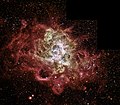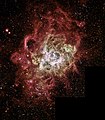File:Ngc604 hst.jpg

Original file (1,179 × 1,346 pixels, file size: 1.58 MB, MIME type: image/jpeg)
Captions
Captions
| DescriptionNgc604 hst.jpg |
This festively colorful nebula, called NGC 604, is one of the largest known seething cauldrons of star birth in a nearby galaxy. NGC 604 is similar to familiar star-birth regions in our Milky Way galaxy, such as the Orion Nebula, but it is vastly larger in extent and contains many more recently formed stars. This monstrous star-birth region contains more than 200 brilliant blue stars within a cloud of glowing gases some 1,300 light-years across, nearly 100 times the size of the Orion Nebula. By contrast, the Orion Nebula contains just four bright central stars. The bright stars in NGC 604 are extremely young by astronomical standards, having formed a mere 3 million years ago. Most of the brightest and hottest stars form a loose cluster located within a cavity near the center of the nebula. Stellar winds from these hot blue stars, along with supernova explosions, are responsible for carving out the hole at the center. The most massive stars in NGC 604 exceed 120 times the mass of our Sun, and their surface temperatures are as hot as 72,000 degrees Fahrenheit (40,000 Kelvin). Ultraviolet radiation floods out from these hot stars, making the surrounding nebular gas fluoresce. NGC 604 lies in a spiral arm of the nearby galaxy M33, located about 2.7 million light-years away in the direction of the constellation Triangulum. M33 is a member of the Local Group of galaxies that also includes the Milky Way and the Andromeda Galaxy. The image of NGC 604 was assembled from observations taken with Hubble's Wide Field Planetary Camera 2 in 1994, 1995, and 2001. Color filters were used to isolate light emitted by hydrogen, oxygen, nitrogen, and sulfur atoms in the nebula and ultraviolet, visible and infrared light from the stars within NGC 604 and the nearby spiral arms of M33. Image processors from the Hubble Heritage team at the Space Telescope Science Institute combined these various filter images to create this color picture. Deutsch: Sternentstehung in NGC604, eine, H-II-Gebiet im Dreiecksnebel (M33), einer Galaxie der lokalen Gruppe. Das ausgeschnittene schwarze Eck kommt von der Geometrie des Detektors in der WFPC2-Kamera des Hubble-Weltraumteleskops |
|||
| Date | ||||
| Source | http://hubblesite.org/newscenter/archive/releases/2003/30/image/a/ (direct link) | |||
| Author | NASA and The Hubble Heritage Team (AURA/STScI) | |||
| Permission (Reusing this file) |
|
|||
| Other versions |
 |
File history
Click on a date/time to view the file as it appeared at that time.
| Date/Time | Thumbnail | Dimensions | User | Comment | |
|---|---|---|---|---|---|
| current | 15:08, 18 May 2016 |  | 1,179 × 1,346 (1.58 MB) | Ahecht (talk | contribs) | Reverted to version as of 20:01, 6 July 2009 (UTC) Unneeded rotation |
| 14:02, 26 April 2016 |  | 1,346 × 1,176 (1.65 MB) | SteinsplitterBot (talk | contribs) | Bot: Image rotated by 270° | |
| 20:01, 6 July 2009 |  | 1,179 × 1,346 (1.58 MB) | Tryphon (talk | contribs) | Better resolution, original size. | |
| 07:19, 9 April 2006 |  | 700 × 799 (93 KB) | White-Silent-Night (talk | contribs) | Firestorm of Star Birth In Galaxy NGC 604. Source: http://hubblesite.org/newscenter/newsdesk/archive/releases/2003/30/ Image Credit: NASA and The Hubble Heritage Team (AURA/STScI) Acknowledgment: D. Garnett (U. Arizona), J. Hester (ASU), and J. Westpha |
You cannot overwrite this file.
File usage on Commons
The following 5 pages use this file:
File usage on other wikis
The following other wikis use this file:
- Usage on ar.wikipedia.org
- Usage on ast.wikipedia.org
- Usage on be.wikipedia.org
- Usage on de.wikipedia.org
- Usage on es.wikipedia.org
- Usage on ja.wikipedia.org
- Usage on lb.wikipedia.org
- Usage on nl.wikipedia.org
- Usage on no.wikipedia.org
- Usage on sk.wikipedia.org
- Usage on sr.wikipedia.org
- Usage on sv.wikipedia.org
- Usage on vi.wikipedia.org
Metadata
This file contains additional information such as Exif metadata which may have been added by the digital camera, scanner, or software program used to create or digitize it. If the file has been modified from its original state, some details such as the timestamp may not fully reflect those of the original file. The timestamp is only as accurate as the clock in the camera, and it may be completely wrong.
| Orientation | Normal |
|---|---|
| Horizontal resolution | 200 dpi |
| Vertical resolution | 200 dpi |
| Software used | Adobe Photoshop 7.0 |
| File change date and time | 14:52, 2 December 2003 |
| Color space | Uncalibrated |